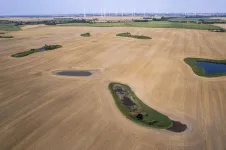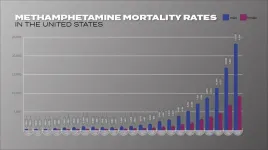(Press-News.org) Bats depend on open bodies of water such as small ponds and lakes for foraging and drinking. Access to water is particularly important for survival in the increasingly hot and dry summers caused by climate change, the time when female bats are pregnant and rear their young. A scientific team from the Leibniz Institute for Zoo and Wildlife Research (Leibniz-IZW) has now shown that access to drinking sites is hampered by wind turbines in agricultural landscapes: Many bat species avoid the turbines and water bodies located close to the turbines for several kilometres. These results have been published in the scientific journal “Biological Conservation”.
In order to counteract climate change, many countries are investing in the expansion of wind energy production in order to reduce greenhouse gases such as CO2 through renewable electricity. However, the expansion of wind power production may also have negative consequences for wildlife and their habitats. This can potentially lead to some wildlife species being less able to cope with global warming. Prof Dr Christian Voigt and Dr Carolin Scholz from the Leibniz-IZW and Hannah Klein from the University of Potsdam showed in a scientific investigation of the acoustic activity of bats in agricultural landscapes that many bat species are displaced by wind turbines near smaller bodies of water. They analysed the spatial behaviour of bats belonging to the three functional guilds of open space foraging bats (that hunt above fields or the canopy of forests), narrow space foraging bats (that hunt in dense vegetations, for example below the forest canopy) and edge space foraging bats (that are specialised in foraging in transition zones such as forest edges). “We were able to clearly recognise that those bats which specialized to forage in the open space and in dense vegetation avoided water bodies when wind turbines were located near them”, says Voigt. “Only species of the guild of edge space foraging bats are apparently not driven away from the water sites by the wind turbines.”
The scientists placed acoustic detectors at a total of 59 small ponds that are permanently filled with water at distances of around 50 to 5,000 metres from wind turbines in northern Brandenburg, a federal state in Eastern Germany. Owing to its glacial history, the study area has more than a thousand of these small ponds, called kettle holes, kettle lakes or pothole lakes, which fulfil important ecological functions even in the intensively used agricultural landscape. “During the reproductive season in July, we measured the acoustic activity of bats at bodies of water at different distances from wind turbines. We paid attention to compare the data for similar conditions, such as a lack of rain and moderate winds”, explains Scholz. “In July, the lactation period of female bats slowly comes to an end and the young are weaned from the nursery roosts, which is an energetically strenuous phase for female bats. In addition, many waterholes dry up in midsummer, which is why the bats may be more dependent on small bodies of water that contain water all year round.”
The team identified a total of almost 8,400 calls of different bat species in the three bat guilds of open space hunters, narrow space hunters and edge spacer foragers. “With increasing proximity to wind turbines, the activity of open space foraging bats at water bodies decreased by 53 percent and the activity of bat species adapted to hunting in narrow vegetation decreased by 63 percent”, the authors summarise. The same picture was revealed when analysing the foraging behaviour that can be identified by the acoustic detectors: It decreased by 87 and 76 percent respectively as the distance to a wind turbine decreased from 5 kilometres to virtually zero.
“There is a certain tragedy in these results, because a measure to mitigate climate change has the unfortunate side effect that certain bats are less able to cope with hot and dry summers if they are displaced from their habitats by wind turbines”, says Voigt. “This emphasises once again how important it is to carefully consider the siting of wind turbines so as not to play off different objectives against each other. Habitats that are very important for species conservation should be given low priority or entirely excluded as sites for wind energy production.”
The bat species studied include the common pipistrelle (Pipistrellus pipistrellus), the soprano pipistrelle (Pipistrellus pygmaeus) and the western barbastelle (Barbastella barbastellus) as representatives of edge space foraging bats, species of the genera noctule bats (Nyctalus), house bats (Eptesicus) and vesper bats (Vespertilio) as representatives of open space foraging bats, and species of the genus mouse-eared bats (Myotis) and long-eared bats (Plecotus) as representatives of narrow space foraging bats.
Bats are protected species under German nature conservation law and EU law and should also be specially protected as migratory species. This protection is conflicting with the expansion of wind energy production, because there are a significant number of direct fatalities at the turbines and the habitats of bats are impaired in many ways. Voigt's team at the IZW has been conducting research into this “‘green-green conflict” between wind power expansion and bat conservation for many years.
END
Wind turbines impair the access of bats to water bodies in agricultural landscapes
2025-01-13
ELSE PRESS RELEASES FROM THIS DATE:
UCF biology researchers win awards from NOAA to support critical coastal work
2025-01-13
Biology researchers in the College of Sciences and UCF Coastal have received two awards from the National Oceanic and Atmospheric Administration (NOAA) totaling more than $2.3 million.
A new $1.1 million award to UCF from NOAA Sea Grant as part of the Marine Debris Challenge Competition will fund joint research between UCF’s CEELAB and Aquatic Biogeochemistry Laboratory’s research on plastic-free restored habitats in coastal shorelines and oyster reefs. UCF’s work, in partnership with Texas A&M, and University of Texas Marine Science Institute was selected as one of 11 projects ...
Geochemist Kevin Rosso appointed a Battelle Fellow
2025-01-13
RICHLAND, Wash.— Geochemist Kevin Rosso, a senior scientific leader at the Department of Energy’s Pacific Northwest National Laboratory, has been named a Battelle Fellow, the highest recognition at PNNL for leadership and accomplishment in science. He joins six other current Battelle Fellows at PNNL in an honor that less than 0.5% of PNNL scientists achieve during their careers.
Rosso is internationally known for his fundamental research on how energy flows among minerals, solutions and microorganisms. These complex processes center on the key role that interfaces—which are shared boundaries—play in controlling ...
NIH-funded study finds cases of ME/CFS increase following SARS-CoV-2
2025-01-13
What: New findings from the National Institutes of Health’s (NIH) Researching COVID to Enhance Recovery (RECOVER) Initiative suggest that infection with SARS-CoV-2, the virus that causes COVID-19, may be associated with an increase in the number of myalgic encephalomyelitis/chronic fatigue syndrome (ME/CFS) cases. According to the results, 4.5% post-COVID-19 participants met ME/CFS diagnostic criteria, compared to 0.6% participants that had not been infected by SARS-CoV-2 virus. RECOVER is NIH’s national program to understand, diagnose, prevent, and treat Long COVID.
The research team, led by Suzanne D. Vernon, Ph.D., from the Bateman Horne Center in Salt Lake City, ...
Biophotovoltaics: A step forward in sustainable energy technology
2025-01-13
In a groundbreaking study published in Environmental Science and Ecotechnology, researchers have advanced our understanding of biophotovoltaic (BPV) systems—innovative devices that merge photosynthetic microbes with electrochemical systems to convert sunlight into electricity. Using the cyanobacterium Synechocystis sp. PCC 6803, the study provides critical insights into the molecular mechanisms driving this green energy technology.
Central to BPV systems is the process of extracellular electron transfer (EET), where electrons generated during photosynthesis are harvested by an electrode via mediators such as ferricyanide. The research reveals that EET ...
Experimental blood test for pancreatic cancer undergoing clinical development and evaluation
2025-01-13
GRAND RAPIDS, Mich. (Jan. 13, 2025) — An experimental blood test for pancreatic cancer that was developed by Van Andel Institute and University of Pittsburgh scientists is being evaluated by a commercial laboratory, an important milestone toward making the test available for patients.
A recent double-blinded, peer-reviewed analysis published in Cancer Letters revealed that the experimental test correctly identified 71% of pancreatic cancer samples in the lab compared to only 44% correctly identified by the current gold-standard test. Teams led by ...
Polygamy is (not) for the birds
2025-01-13
Researchers at Rice University have uncovered new insights into the evolution of bird behavior, revealing why certain mating systems persist while others disappear over time. In a recent paper published in the journal Evolution, Rafael S. Marcondes and Nicolette Douvas reveal that lekking — a mating system where males display for females without forming lasting bonds — is an evolutionarily stable strategy. In contrast, resource-defense polygamy, where one sex — usually but ...
Hubble reveals surprising spiral shape of galaxy hosting young jet
2025-01-13
The night sky has always played a crucial role in navigation, from early ocean crossings to modern GPS. Besides stars, the United States Navy uses quasars as beacons. Quasars are distant galaxies with supermassive black holes, surrounded by brilliantly hot disks of swirling gas that can blast off jets of material. Following up on the groundbreaking 2020 discovery of newborn jets in a number of quasars, aspiring naval officer Olivia Achenbach of the United States Naval Academy has used NASA’s Hubble Space Telescope to reveal surprising properties of one of them, quasar J0742+2704.
"The biggest surprise was seeing the distinct ...
Study: US methamphetamine mortality 61 times higher in '21 than 1999
2025-01-13
OXFORD, Miss. – Methamphetamine deaths in the U.S. rose 61-fold from 1999 to 2021, according to a new study, highlighting a growing crisis in addiction and public health.
Looking at the gender breakdown of these deaths could improve harm-reduction efforts and outcomes for patients suffering from addiction, said Andrew Yockey, University of Mississippi assistant professor of public health and co-author of the study.
“We know that, across the board, men are more likely to use every substance except tranquilizers than women, and we found that to be true here,” Yockey said. “Especially if we're thinking about methamphetamine, ...
Atop the Oregon Cascades, UO team finds a huge buried aquifer
2025-01-13
THIS PUBLICATION IS EMBARGOED UNTIL 3 PM EASTERN TIME ON JANUARY 13, 2025.
Oregon’s Cascade Range mountains might not hold gold, but they store another precious resource in abundance: water.
Scientists from the University of Oregon and their partners have mapped the amount of water stored beneath volcanic rocks at the crest of the central Oregon Cascades and found an aquifer many times larger than previously estimated — at least 81 cubic kilometers.
That’s almost three times the maximum capacity of Lake Mead, ...
Bay Area community leader champions CPR education and heart health on national platform
2025-01-13
DALLAS, Jan. 13, 2025 — Corey Bentley, an American Heart Association local volunteer and marketing professional in the San Francisco Bay Area, is the Association’s 2024 National Leaders of Impact™ Winner. In the fall of 2024, more than 300 local leaders in 60 communities volunteered to improve heart health while raising funds to fuel the lifesaving mission of the Association, through its nationwide Leaders of Impact campaign. The head-to-head competition doesn’t just focus on raising critical funds. It also supports access to equitable health in local communities given that health inequities related to uncontrolled high blood pressure rates, tobacco ...






